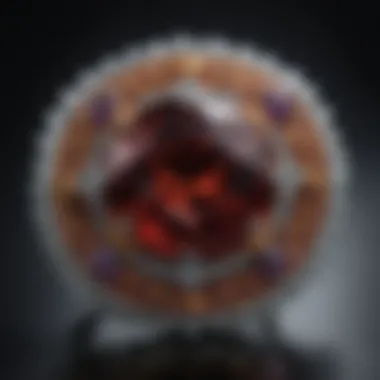Mass Production Jewelry Manufacturers: A Deep Dive


Intro
In the ever-evolving landscape of jewelry, the term 'mass production' resonates deeply. It embodies a fusion of efficiency and accessibility. As mass production jewelry manufacturers become the mainstay in the industry, understanding their operations, techniques, and wider implications is crucial. From the intricate processes behind the scenes to the choices available to consumers, this exploration sheds light on the dynamic interplay of craftsmanship and marketing in the world of gemstones.
Gemstone Overview
Definition and Characteristics
Gemstones, often viewed as symbols of luxury and beauty, are more than just aesthetically pleasing objects. These minerals, often cut and polished, possess unique properties that make them valued both in jewelry and as collectibles. Their hardness, brilliance, clarity, and color are the defining characteristics that elevate them from ordinary stones to prized possessions.
For instance, a diamond’s exceptional hardness makes it desirable for engagement rings, while sapphires and rubies known for their rich hues, capture the imagination of both collectors and designers alike.
Classification of Gemstones
Gemstones are typically classified into two main categories: precious and semi-precious. The distinction is rooted in tradition rather than scientific rigor. Precious stones like diamonds, emeralds, sapphires, and rubies are often perceived as more valuable, while semi-precious stones encompass a wide array of varieties including amethyst, garnet, and turquoise.
- Precious Gemstones:
- Semi-Precious Gemstones:
- Diamonds
- Rubies
- Sapphires
- Emeralds
- Amethyst
- Topaz
- Aquamarine
- Garnet
The trend of mass production has significantly affected the classification and availability of these gemstones, making previously rare stones accessible to a broader audience.
"The journey of gemstones from the earth to the final consumer's jewelry box is as valuable as the stones themselves."
Historical Significance
Ancient Uses and Cultural Importance
The allure of gemstones dates back millennia. Ancient civilizations revered them for more than just their beauty. From the Egyptians adorning themselves with lapis lazuli to the Greeks crafting intricate jewelry with agate, these stones were believed to hold mystical properties. Many cultures used gemstones as talismans or in rituals, each stone associated with different meanings and powers.
Myths and Legends Surrounding Gemstones
The magnificence of gemstones has also birthed a plethora of myths and legends. The ruby, often considered the "king of gemstones," was believed to bestow health and wealth upon its owner. In contrast, the emerald was linked to fertility and rebirth, often gifted to brides for luck in marriage.
These narratives enhance the appeal of gemstones, creating an emotional connection that modern mass production attempts to replicate by increasing accessibility, albeit sometimes at the cost of the original craftsmanship.
The subsequent sections will delve deeper into the manufacturing processes, the impact of mass production on the jewelry industry, and its repercussions for artisans and consumers alike. Through these lenses, we can appreciate the multifaceted universe of mass production jewelry manufacturers.
Overview of Mass Production in the Jewelry Industry
Understanding mass production in the jewelry industry is like peeking behind a curtain that conceals the mechanisms of both creativity and commerce. It’s not merely about making things quickly; it embodies the delicate balance between artistry and efficiency. As consumers, we often overlook how jewelry transitions from raw materials to brilliantly crafted pieces that end up in showcases. Recognizing this process offers insights into why certain pieces are beloved while others may fade into obscurity.
Mass production revolutionized how jewelry is created and marketed. This technique allows manufacturers to produce countless items, delivering a wide variety of designs without sacrificing quality. Moreover, brands gain the ability to meet consumer demand effectively, addressing broader market shifts with agility.
Historical Context
Tracing back to the onset of the Industrial Revolution, the jewelry industry began embracing mass production as artisans transitioned from solo craftsmanship to factory production. Tools and techniques started evolving; the transition was marked by a shift towards mechanical methods. In the 19th century, diamonds and other precious stones became widely available, making them attainable for those who might never have dreamed of owning them. This change ignited an insatiable demand for jewelry, linking mass production and consumer desires dynamically.
"The evolution of mass production in jewelry mirrors the broader narrative of industrial progress and consumer culture."
In the early 20th century, methods such as electroplating emerged, leading to further innovations. The introduction of assembly lines allowed a more streamlined method of production, where different individuals focused on distinct aspects of jewelry making. This not only sped up the process but also democratized luxury. People from various walks of life were able to enjoy adornments that were once confined to the elite.
Defining Mass Production
So, what exactly do we mean by mass production? At its core, mass production in jewelry refers to the ability to create large quantities of items through standardized processes. This includes everything from casting and molding to finishing techniques.
The essence of mass production includes several key characteristics:
- Standardization: Similar pieces crafted with uniform specifications, ensuring consistency in quality and design.
- Automation: Increasingly reliant on machines and technology to perform tasks that were once done manually, enhancing precision while reducing labor costs.
- Economy of Scale: As production scales up, the cost per unit decreases, making jewelry more accessible to consumers.
Overall, the medium allows for diverse styles that reflect ongoing trends, catering to a wide audience. In a world where personalization is becoming increasingly coveted, mass production might seem counterintuitive, yet it adeptly narrows down choices to what resonates most with consumers.


In summary, comprehending the overview of mass production in the jewelry industry sets the stage for deeper discussions on manufacturing techniques, technological advancements, and market dynamics—a journey that promises to enlighten enthusiasts, collectors, and designers alike.
Manufacturing Techniques in Mass Production
In the realm of mass production, the techniques employed can make or break a manufacturer’s efficiency and product quality. These methods not only dictate the feasibility of producing jewelry items at scale but also determine the craftsmanship involved in the final product. Understanding these techniques sheds light on how mass-produced jewelry maintains consistency while meeting the diverse tastes of consumers. In this article, we delve into the essential manufacturing techniques that define the landscape of mass production in the jewelry industry.
Casting Methods
Casting remains a cornerstone technique in jewelry manufacturing. At its core, this method involves pouring molten metal into a mold to create various designs. The advantage of casting lies in its ability to reproduce intricate details consistently, which is crucial for brands aiming to maintain a recognizable aesthetic. Different methods, such as lost-wax casting and sand casting, serve distinct purposes.
- Lost-Wax Casting: This age-old process starts with creating a wax model of the jewelry design. Once the wax is shaped, it's coated in a ceramic material, then heated to melt away the wax, creating an empty mold. Finally, metal is poured into the mold. This technique is favored for its ability to capture fine details and complex shapes.
- Sand Casting: Often utilized for larger, bulkier designs, this technique uses sand to create the mold. It's less precise than lost-wax casting but considerably quicker, making it suitable for mass production where speed is paramount.
Automation in Jewelry Making
As in many industries, automation has revolutionized the jewelry manufacturing sphere. Automation not only boosts productivity but also ensures a level of consistency that manual labor simply can’t match. Two prominent facets of automation include robotics and advances in software and 3D printing.
Robotics in Jewelry Production
The integration of robotics in jewelry production has brought about a significant shift in how pieces are crafted. Automated machines can handle repetitive tasks like polishing, engraving, and even assembly. This allows human workers to focus on more complex and creative tasks. The key characteristic of robotics in this context is precision. Robots can execute intricate work with remarkable accuracy, reducing the likelihood of human error and increasing throughput.
One unique feature of robotic systems is their ability to operate continuously, which leads to increased efficiency. However, the initial setup cost can be steep, and there's an ongoing debate regarding the implications for employment within the industry. Still, the potential benefits such as lower labor costs and consistent quality make this technology a tempting investment for manufacturers.
Software and 3D Printing
Another modern marvel reshaping jewelry manufacturing is the combination of specialized software and 3D printing technologies. Software programs enable designers to create complex models that can be printed directly into 3D forms. This approach allows for rapid prototyping, which is invaluable in testing designs before committing to mass production.
The notable feature of 3D printing is its flexibility. Designers can easily make changes to designs and instantly print new iterations, which means that customization can be offered even within a mass production framework. However, the layer-by-layer building process can sometimes lead to structural weaknesses, which needs addressing to ensure the final product maintains robustness.
Quality Control Measures
Maintaining high standards in mass production is essential. Quality control measures, such as inspections and standardized testing, play a vital role in ensuring that the pieces produced meet specified criteria. This entails not only checking the aesthetic aspects but also guarantees that materials are sourced ethically, with attention to durability and long-term wearability.
"Quality in a product or service is not what you put into it; it is what the client or customer gets out of it."
Adopting comprehensive quality control checks helps in building customer trust and loyalty, essential commodities in today's competitive market. As mass-produced jewelry continues to evolve, the techniques employed must balance speed with the integrity of the final product. Understanding these nuances equips enthusiasts and professionals alike with the knowledge to appreciate the intricacies of jewelry mass production.
The Role of Technology
In today’s fast-paced world, technology stands as a cornerstone in the sculpture of mass production in the jewelry industry. Its significance transcends mere implementation; it influences design, efficiency, and even market reach. As jewelry manufacturers embrace the tools of modern innovation, they not only streamline their production capacities but also enhance creativity and customization options for the consumer. The role of technology has allowed for the reduction of human error, boosted productivity, and improved customer satisfaction, reshaping how jewelry is both created and marketed.
Advancements in Production Technology
Computer-Aided Design (CAD)
Computer-Aided Design (CAD) operates as a game-changer in the field of jewelry manufacturing. It offers jewelers a powerful platform to create intricate designs with precision that was previously unattainable using traditional methods. This technology enables artists to visualize their creations in a 3D format, making it easier to tweak and refine designs before physically producing them. The key characteristic of CAD is its ability to combine creativity with technical accuracy, making it a perfect blend for today’s jewelry designers.
Some may wonder, why is CAD so popular among mass production manufacturers? It’s primarily due to its effectiveness in minimizing mistakes and optimizing resources. CAD’s unique feature is the ability to reproduce complex designs repeatedly without sacrificing quality – a vital factor when producing jewelry in large quantities. However, it’s worth noting that investing in CAD software and related training comes at a significant cost, which may not be feasible for smaller businesses.
Laser Cutting and Engraving
Another fascinating aspect of advancements in production technology is Laser Cutting and Engraving. This method introduces a new level of precision that traditional cutting tools simply cannot provide. Laser technology allows for intricate patterns and detailed engraving, opening doors to customization like never before. The key characteristic of laser cutting is its speed and accuracy; it cuts through materials smoothly, reducing waste and increasing production efficiency.
This technology is particularly beneficial for mass producers as it streamlines the workflow. Unique features such as adjustable settings on the laser equipment provide flexibility, enabling jewelers to work with various materials and thicknesses. However, while the benefits are numerous, manufacturers also face challenges. The cost of laser machines can be daunting, and proper training is crucial to ensure safety and effective use.
Impact of E-commerce
The intersection of technology and commerce is most evident in the rise of e-commerce within the jewelry sector. Online platforms allow manufacturers to reach a broader audience, transcending geographical limitations. For consumers, this evolution means more choices at their fingertips. They can browse extensive catalogs from the comfort of home, compare prices, and read reviews before making a purchase.
E-commerce has transformed marketing strategies and customer relationships. The ease of setting up an online store has empowered smaller manufacturers to showcase their work alongside larger brands. With effective SEO practices and social media engagement, they can amplify their visibility and appeal directly to niche markets.
Mass Production vs. Bespoke Jewelry
When delving into the jewelry industry, the contrast between mass production and bespoke jewelry becomes a pivotal topic that deserves thoughtful exploration. Understanding these two approaches is crucial for enthusiasts, collectors, and designers alike, as they grapple with different values, aesthetics, and even philosophies surrounding the art of adornment.


Understanding Bespoke Jewelry
Bespoke jewelry stands tall as a symbol of individuality and craftsmanship. Unlike mass-produced items that roll off assembly lines, bespoke pieces are meticulously crafted for a specific client. This craftsmanship often means that artisans take into account personal stories, preferences, and unique characteristics when creating a piece. When a person seeks a bespoke jewelry item, they enter a collaborative dialogue with a jeweler, discussing everything from materials to design concepts. The process is often lengthy, sometimes taking months to complete.
In a sense, bespoke jewelry is like a fine tailored suit; it molds to the wearer's desires and needs rather than conforming to a pre-fabricated standard. The emotional connection that comes with a custom piece adds a layer of significance that most mass-produced jewelry simply cannot offer. This uniqueness often results in a higher price tag, reflecting not just the materials used but also the skill and time invested in each piece.
Pros and Cons of Mass Production
Mass production in the jewelry world presents its own set of complexities. On one hand, it offers accessibility to the masses. With global brands like Pandora or Tiffany & Co., jewelry lovers can find trendy pieces without breaking the bank. On a larger scale, this accessibility helps introduce more individuals to the world of jewelry, potentially fostering new enthusiasts.
However, there are also downsides to consider. One major drawback is the lack of individuality. Mass-produced items often follow fashion trends, resulting in countless others wearing the same piece. This can diminish the exclusivity that many jewelry enthusiasts crave.
Let's break down some key points regarding mass production:
- Affordability: Mass-produced jewelry tends to be less expensive, appealing to a broader audience.
- Availability: Easily accessible in various retail outlets or online platforms.
- Trend-driven: Pieces can quickly follow current fads, allowing for a dynamic yet sometimes superficial shopping experience.
Nevertheless, mass production is called into question for its quality, which may not match that of custom pieces. Consumers may find themselves pondering the longevity and craftsmanship of a mass-produced item versus a unique bespoke design, raising concerns about wearability and sentimental value.
"In the end, choosing between mass-produced and bespoke jewelry is not merely a shopping decision; it reflects one’s values, aesthetics, and intentions behind the jewelry purchased."
Market Dynamics
Understanding the market dynamics of mass production jewelry is critical, not just for industry insiders but also for consumers and collectors who desire insight into purchasing patterns and trends.
The jewelry market operates under forces that dictate how products are created, marketed, and consumed. A few key elements play significant roles:
- Consumer Preferences: Shifts in what buyers want impact manufacturing processes.
- Global Trends: External factors, such as economic conditions, also influence the market.
In particular, the importance of awareness around consumer preferences cannot be overstated. This understanding aids manufacturers in crafting products that resonate with their audiences while balancing innovation and cost.
Trends forming part of this dynamics can be observed globally, with various factors emerging that reshape the industry's landscape and consumer choices.
Consumer Preferences
Consumer preferences are the lifeblood of the jewelry market, reflecting changing aesthetics and lifestyle choices. Particular attention must be paid to how these preferences shift over time, influenced by culture, social media, and individual tastes.
- Personalization: In a world driven by individual expression, consumers increasingly seek unique pieces that tell their stories. This has nudged many manufacturers to blend mass production techniques with elements of customization.
- Sustainability: There's a growing conscience regarding the environment that aligns consumer choices with brands that promote ethical sourcing and sustainable practices. For instance, jewelry brands that utilize recycled materials or ethically sourced gems tend to attract a more eco-minded clientele.
- Price vs. Quality: A balancing act occurs as consumers navigate between affordability and the desire for high-quality craftsmanship. Mass production often leads to reduced prices, which can influence buying decisions heavily.
As consumers evolve, manufacturers must keep their finger on the pulse and adapt their offerings accordingly, ensuring that they meet or exceed shifting expectations.
The Global Jewelry Market Trends
When it comes to global jewelry trends, these encapsulate more than just aesthetic shifts; they involve economic, technological, and cultural currents that shape purchasing behavior.
- Technological Advancements: Innovations, such as augmented reality for virtual try-ons and online customization tools, are revolutionizing how consumers interact with jewelry brands. These technologies not only enhance the shopping experience but also cater to the desire for instant gratification.
- E-commerce Surge: The rise of e-commerce platforms has made buying jewelry more accessible. With the click of a button, consumers can compare prices from various manufacturers—potentially altering traditional distribution models.
- Cultural Influence: Jewelry trends often borrow from various cultural elements, merging different styles that reflect global interconnectedness. For example, the adoption of minimalist design from Scandinavian influences alongside vibrant, traditional pieces from various cultures creates a melting pot of styles.
Ultimately, the underlying currents of market dynamics in mass production jewelry are multi-faceted, revealing not just the mechanics of buying and selling but also how socio-economic changes influence production processes. Embracing consumer preferences and trends allows manufacturers to align their strategies with contemporary diverse demands and market variability.
Challenges Faced by Manufacturers
In an industry as intricate as jewelry manufacturing, mass production comes with its own set of hurdles. These challenges not only affect the production process but also impact the quality of the end product, as well as sustainability and ethical considerations. With consumers becoming more informed and concerned about how their jewelry is produced, understanding these challenges is imperative for manufacturers aiming to stay relevant in a competitive marketplace.
Sustainability Issues
Sustainability in mass production jewelry is a topic that simply can’t be ignored. Many manufacturers find themselves grappling with the environmental impacts of their operations, which range from energy consumption to waste generation. The process of creating jewelry on a large scale often involves chemicals and materials that are not eco-friendly. For instance, certain metals may require mining practices that disturb ecosystems and leave a hefty carbon footprint. Consequently, some manufacturers are reevaluating their processes to incorporate more sustainable options.
"Sustainability is no longer just a trend; it’s a necessity in today's global market."
A few approaches that manufacturers are exploring to address sustainability include:
- Using recycled materials: By repurposing old jewelry and using recycled metals, manufacturers can help reduce the demand for new raw materials.
- Adopting eco-friendly practices: Implementing technologies that minimize energy use or waste can drastically lower a company’s environmental impact.
- Educating consumers: Transparency is key. By informing customers about the sustainability of their products, manufacturers can build trust and encourage more responsible purchasing decisions.
Ethical Sourcing of Materials


The question of ethical sourcing is also a pressing issue for mass production jewelry manufacturers. In recent years, there has been a significant push for accountability in the jewelry industry, especially concerning the origins of precious stones and metals. Consumers increasingly seek assurance that their purchases do not contribute to conflicts or human rights abuses.
To navigate these waters, manufacturers must ensure that their supply chains are not just efficient but also responsible. This could involve:
- Regular audits of suppliers: Verifying that suppliers adhere to ethical sourcing guidelines helps to maintain integrity throughout the production chain.
- Certification: Obtaining certifications such as Fair Trade or Responsible Jewelry Council (RJC) can signal to consumers that a manufacturer prioritizes ethical standards.
- Collaborative efforts: Engaging with NGOs or industry groups to work towards better standards for sourcing materials can foster improvement at a broader level.
In summary, the challenges of mass production in the jewelry sector span far beyond mechanical issues or economic factors. Tackling sustainability and ethical sourcing effectively can set manufacturers apart in a crowded market while contributing to a fairer and greener future for the jewelry industry.
Case Studies of Notable Manufacturers
In the vast realm of jewelry manufacturing, case studies of notable manufacturers reveal not only the mechanics of mass production but also the strategic decisions that define successful businesses. These cases serve as a mirror into the industry's psyche – showcasing innovation, resilience, and the aggressive pursuit of excellence. By examining specific examples, we gain a clearer picture of how manufacturers adapt to market demands while maintaining quality in their craft.
Innovative Mass Production Companies
Within the landscape of mass production jewelry, several companies stand out due to their innovative approaches. One such manufacturer is Tiffany & Co., renowned for pushing the boundaries of traditional craftsmanship while embracing modern techniques. The brand employs advanced technology like computer-aided design (CAD) to streamline the design process. This not only enhances creativity but also ensures consistency in quality across thousands of pieces.
Another pioneering entity is Zales, which has adopted a multi-channel retailing strategy. By integrating both physical stores and e-commerce, Zales captures a wider market share. They combine mass production techniques with seasonal collections that cater to current trends, demonstrating how flexibility can drive growth.
These companies illustrate that innovation is not purely about technology; it also encompasses strategic maneuvers that align with consumer behavior. As market demands shift, these manufacturers prove that being adaptable is key.
Successful Strategies in Production
Effective strategies are the backbone of successful mass production. One approach many manufacturers leverage is just-in-time production. This strategy minimizes inventory costs by producing jewelry only as orders come in. For instance, Swarovski, known for its crystal jewelry, utilizes this model to maintain a lean production cycle while satisfying customer preferences for unique, on-trend designs.
Additionally, Macy’s has developed strong partnerships with local artisans. This not only improves production speed but also enhances the brand's image by supporting community craft. Such collaboration can facilitate quicker turnaround times and reduced costs while still celebrating craftsmanship.
"The secret to staying relevant in jewelry production lies in recognizing and adapting to consumer trends while ensuring quality isn't sacrificed."
By fostering strong supplier relationships, companies like Jared can streamline their operations, resulting in reduced costs that benefit both the company and the consumers. This interconnectedness between manufacturers and suppliers often proves to offer a competitive edge in today's rapidly changing market environment.
In summary, these case studies exemplify what happens when tradition meets modernity. By focusing on well-planned strategies and innovative production techniques, notable manufacturers not only thrive in mass production but also set the tone for the future of the jewelry industry. Each story of success offers invaluable lessons on adaptability and the constant pursuit of excellence, fundamental truths for anyone looking to navigate this intricate arena.
Future of Mass Production in Jewelry
The future of mass production in the jewelry sector is a topic worthy of attention, especially as it intertwines with technological advancements and shifting consumer expectations. As we look ahead, various factors shape this industry, from innovations in manufacturing to evolving market trends.
Emerging Technologies
The rise of emerging technologies is leading the charge in transforming mass production methods. One cannot ignore the impact of artificial intelligence in streamlining operations. Through machine learning algorithms, manufacturers can now predict trends more accurately. This prediction helps in minimizing waste and optimizing inventory.
Another game-changer is the incorporation of 3D printing in production processes. This technology provides both efficiency and flexibility. Jewelry designers can use 3D printing to create custom pieces rapidly, catering to individual tastes without throwing off the entire production line. It’s a process that could very well balance the quantity and customization expectation from consumers.
Furthermore, augmented reality (AR) is making waves within retail environments. By using AR applications, customers can visualize how a piece will look on them before making a purchase, thereby enhancing the shopping experience. This technological incorporation not only attracts more clients but also fosters customer satisfaction, a crucial aspect for retention in today's competitive market.
Potential Market Shifts
Market dynamics are continually evolving, and the mass production jewelry sector has to keep pace. One significant shift is the growing inclination toward sustainable practices. More consumers are becoming environmentally conscious, expecting brands to adopt ethical sourcing and environmentally friendly methods in their production processes. The demand for transparency is louder than ever. Customers are keen to understand where their materials come from and the ethical considerations behind them.
Additionally, there's an observed surge in the popularity of personalized jewelry. Traditional mass production often leaned towards a one-size-fits-all approach. However, as tastes diversify, the industry is witnessing an increasing segment of the market seeking uniqueness in their jewelry pieces. Brands that can incorporate mild customization options in their mass production lines will likely find a friendly reception.
"The confluence of technology and consumer expectations is setting the stage for a radical transformation in the jewelry industry; it’s about meeting demands without losing the essence of craftsmanship."
In short, the future of mass production in jewelry reflects both challenges and opportunities. Advanced technologies pave the way for more customer-centric approaches, while the shifts in consumer preferences compel manufacturers to rethink their strategies. As we’re living through this transition, it’s essential for brands to remain agile, prepared to adapt to the changing tides.
The End
In wrapping up our exploration of mass production in the jewelry sector, it's crucial to reflect on the multifaceted nature of this topic. The implications of mass production stretch far beyond the factory floor; they shape consumer behavior, ethical considerations, and the future trajectory of the industry itself. One cannot underestimate the impact of reduced production costs and increased accessibility that mass production offers. This democratization of jewelry, once a luxury for the few, now makes ornamental pieces attainable for the many.
Recap of Key Insights
To summarize, mass production has not just revolutionized the production methods in the jewelry industry but has served as a double-edged sword. Here are several salient points that emerged:
- Cost Efficiency: Mass production allows manufacturers to create jewelry at scale without compromising on availability. This is a boon for companies aiming to serve a broader market.
- Technological Integration: The rise of technology—particularly computer-aided design and automation—has infused the production process with precision and reduced human error.
- Quality Control Challenges: While efficiency can be achieved, maintaining the quality that consumers demand remains an ongoing challenge for many manufacturers.
- Consumer Preferences: As trends have shifted, mass-produced jewelry has had to adapt, leading to innovations in design to meet diverse tastes while remaining affordable.
- Sustainability Concerns: Discussions surrounding ethical sourcing of materials and environmental sustainability are becoming increasingly relevant, painting a complex picture of modern mass production.
Final Thoughts on the Industry's Future
Looking ahead, the future of mass-produced jewelry seems to teeter on a precarious balance. As consumers become more informed and critical of their purchases, manufacturers must align their practices with ethical standards. In an age of environmental awareness, the integration of sustainable practices will not just be beneficial—it's becoming essential.
Moreover, the emergence of customization technologies could redefine what mass production means. Imagine a world where consumers can personalize elements of mass-produced jewelry without incurring exorbitant costs. The notion of individual expression may soon intertwine seamlessly with mass production, leading to innovative offerings that cater to both the collective and the unique.







